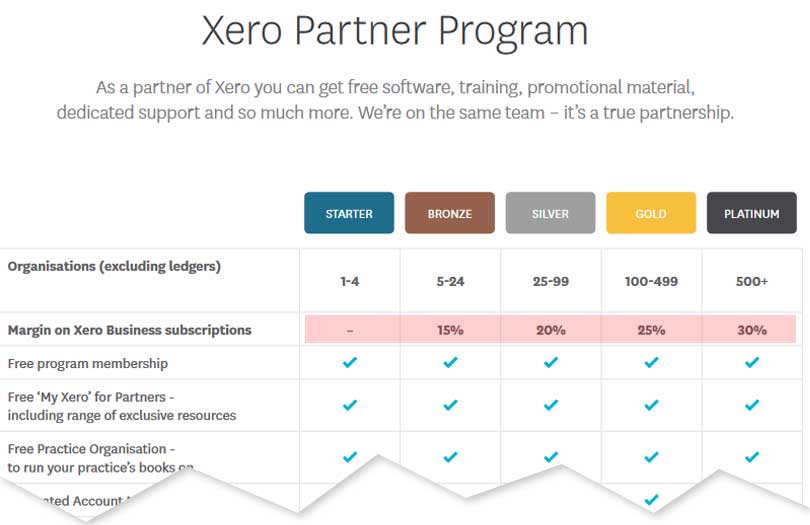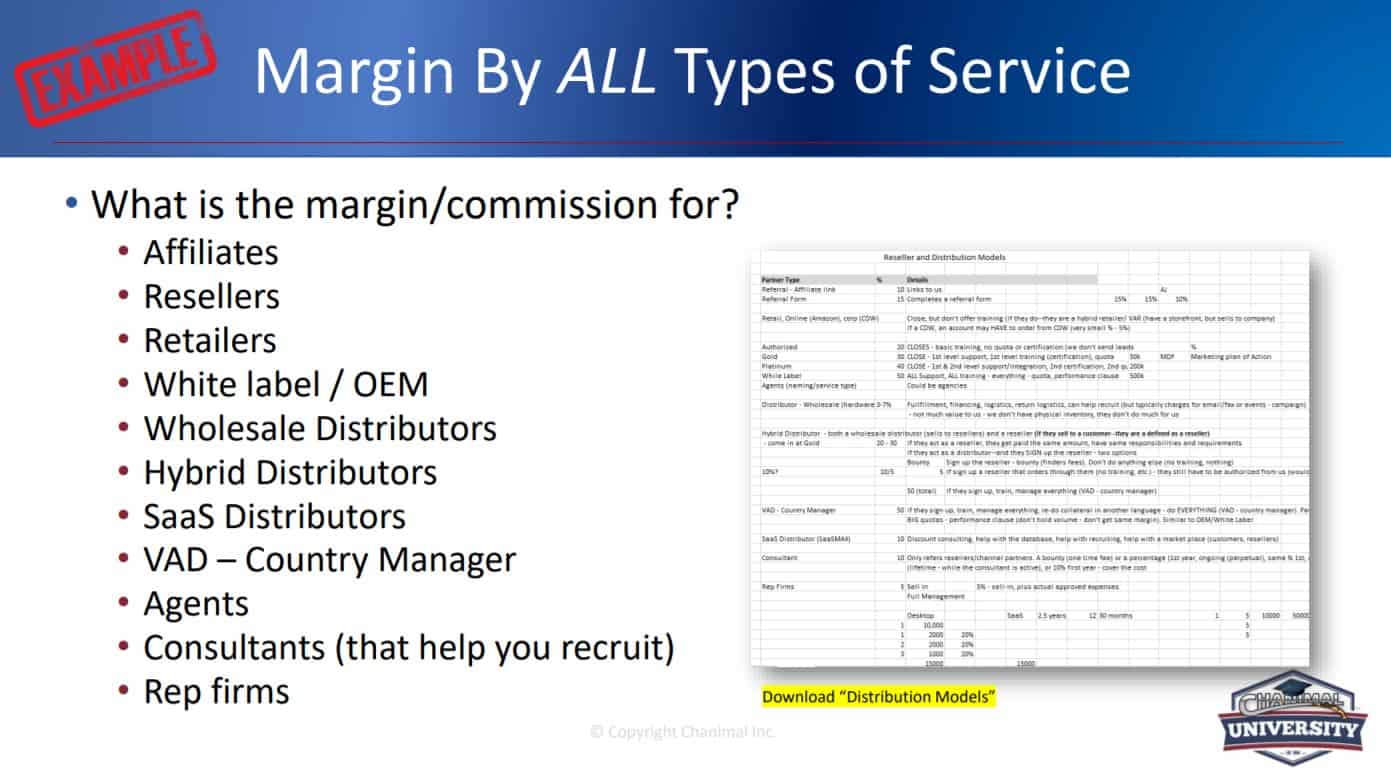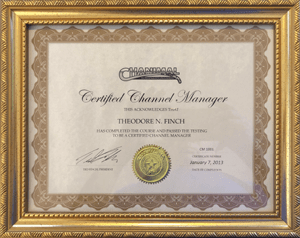How to Determine Reseller Margins
When creating a reseller program, you always have to determine the margins for your affiliates (link referrals and referral forms), resellers (retail through VARs) and even white-label partners. The white label can be more customized, but your affiliate and reseller margins should be consistent (imagine having 1,000 partners and each one has different terms and pricing–it is near impossible to manage). Here are the detailed steps and items to consider for each reseller type:
NEW! Want more info on how to set up your margins? Watch the VIDEO?
Take the FREE trial for the Certified Channel Manager course. It contains four free lessons–one is the actual lesson on MARGINS used to train channel manager. Click HERE (opens in its own window) to enroll (quick & no cost) and view the video.
SaaS Reseller Margins
- Review the Chanimal presentation, “How to Create a SaaS Reseller Program” (opens in a new window)- slide 32 on margins. You can also watch the video and go to time 47:39 where it talks about the channel and discusses the margins HERE at 49.15.
- Compile competitors’ margins. You can sometimes find it on 1) your competitor’s website (Click Sample Reseller Margins – for an example (Xero accounting)), by 2) sending an email to the channel manager (use a generic email address), or even by asking a reseller about their program (some will send you the entire kit). You can often 3) Google it, “Microsoft margins,” or “How much margin does Microsoft pay,” “What is the commission for Microsoft,” etc. (try different combinations – often it is on a website and Google can find it). Questions to Ask:
- Who pays who? Do I place the order and pay you, or do you collect and pay me?
- Do you have levels?
- Where do you start? The lowest, or can we come in higher?
- What margins do you pay for each of the levels?
- What are the qualifications per level?
- How long do you pay?
- How soon do you pay?
- Do you have a partner program page that explains this or a document you can send?
- Determine margins for “like” products if you can’t find any exactly like yours. For example, if you sell enterprise software to IT, you might compare it to Oracle, Microsoft, etc. Find out as above.

- Determine how much to pay (by level). Examples: 10% affiliate, 20% authorized, 30% gold, 40% platinum? This is not the actual % – these numbers are only an example (competitive research will tell you). Tip: you will probably be a price taker (and margin taker) in a competitive market.
- Examine what behavior you want to reinforce--do you want your resellers to support the account after the first year? Can they switch the customer to another product at the end of the year (if they don’t make any further commission)?
- Over what period do you pay? a) over the first year, b) over a few of the years, c) over the entire life, c) combination. Even enterprise pay after the first year – 20% maintenance fee, or upgrades.
- Do you pay the same amount the first year and subsequent years, or does it vary? Example: 30% first, 15% second and thereafter.
- Who collects and who pays who? Do you collect and pay the reseller a “commission” or do they collect and pay you the balance after their margin? 70% collect (for SaaS) – 30% resellers collect.
- How quickly do you pay? Bad Example (Salesforce). They collect. They pay 30 days after the end of each quarter. If you make 1,000 in commission and it will take 4 months before you see anything!! You should pay as fast as you can afford–within 30 days. (See SoftLetter Stats for actual by company type).
- When through, test your margins with your resellers, then finalize.
VAR or MSP Margins
If you don’t have a SaaS product, the margins are easier to figure out–you just follow the first five steps above.
However, there are other reseller margins that you still have to calculate, a maintenance agreement price or an upgrade price. The industry average for maintenance ranges from 10-25%, with 20% being the most common. Upgrade prices vary more. Regardless, you would still pay a margin on maintenance agreements and upgrades if they are sold through your partners. Many vendors will allow partners to sell their upgrades exclusively up to 10-30 days prior to the due dates–and then it is fair game for the company to attempt to sell them direct so there is no lapse in coverage (for maintenance).
Retail Margins
Retail products can be sold direct, but they are typically sold through a distributor. For local resellers, they might order direct through the distributor catalogs (paper or online). For the regional and national chains (Best Buy, Wal-Mart, Fry’s Electronics, etc.) you would first have to sell into the chain via the buyer.
Some buyers will commit to volume and then you use that to sign up a distributor. Others will require a distributor first (they carry too many SKUs to order direct and prefer a wholesale distributor for financing terms, savings for shipping, returns, etc.). In these cases, you have to also add the margin for a wholesale distributor (typically 3-7%). They charge a margin but often require a co-op (percentage of sales) that could later be applied toward distributor promotions (different ways to get more margin).
Many products are sold through national retailers, independents, and VARs (think MS Office). You would still have similar overall margins regardless of the channel. If the national chains get more margin because of their volumes, then many retailers will order through an aggregator like the Ascii Group. They will order in mass to get you better discounts and then have a smaller margin and parse it out to their members (smaller retailers).
Affiliate Margins
Margins for affiliate programs for software are typically 10-15%. However, some competitors may get extreme and offer 30-50% margins (they are just happy to have anyone trying to push their product). Many of your competitors will have their affiliate margins on their websites. You can also find out what the going affiliate margin in and the terms (first year, perpetual, etc.) by using one of the affiliate directories or Commission Junction. These locations come and go, so Google “Affiliate Directories” and you’ll find them. Search for your category, and you can view competitors’ margins and programs in one convenient place.
Once you know your competitor’s margins you have to determine if you will match, undermine are pay less. If you are late to the market and have a relatively unknown brand, you are a “margin taker” (similar to a price taker) and others have already set the expectation. You have had to pay accordingly (the going rate).
Sample Models – avoiding Exclusivity
Sometimes when setting up a program you are tempted (desperate) to create one-off agreements. Many resellers will try to negotiate these when a vendor doesn’t have a formal program to lock up exclusive advantages. However, it becomes messy when you start growing–especially if your deals did not include a performance clause (must sell a select volume within a select time frame to retain exclusive advantages).
It helps to see a model of all types of partner types so you can map what the partner does (and their respective value) to the typical margins. Unless it is a hard-to-get-into country, like Japan, I do NOT recommend exclusive deals. I had one vendor out of Australia that created an exclusive deal with a single reseller in California that got California, Nevada, and Oregon as an exclusive territory. There was a 3-year time limit but no performance clause. California is the 17th largest economy in the world–bigger than entire countries and this reseller only sold regionally. We were able to unwind it–but what a mess!
Distribution Models (Excel) is a spreadsheet that shows many of these models with typical responsibilities and margins. It is not fully explanatory–but I use it to explain the options when dealing with one-off offers to different partner types.
Definition – Difference between “Points” and “Percentage”
Often in wholesale distribution, you hear the term, “points.” For example, I gave my distributor 50 points (it refers to point mark-up). Although often thought of as the same, it is not the same as a 50% margin. The problem comes from the difference between markup and margin (also called gross profit). Mark-up is the percentage of the amount you earn on the cost of an item you sell. Gross profit (or margin) is the percentage of the amount you earn on the selling price of the item. Here is how to compute it:
Mark-Up
- You purchase the software from distribution at $50 and sell it in retail for $80–or $30 above cost. Divide the earnings ($30) by the distributor price you paid ($50) and you get 60%–that’s your % mark-up on the cost.
Gross Profit (margin)
- You purchase the software for $50 and sell it in retail for $80–or $30 above cost. Divide the earnings ($30) by the selling price ($80) and your get 37.5%–that’s your margin or gross profit on the selling price. This means you earned 37.5 cents on each $1 of sales–to meet your expenses of operation and net profit if any.
Put another way, the gross profit margin is figured on the sales price of an item, and the markup is based on cost. Historically, retailers used the markup method to determine the sales price while manufacturers used the gross margin method. However, in today’s retail environment, both terms are often used interchangeably to mean gross margin.
The markup method involves increasing the price of an item by a certain percentage over cost. For instance, software that cost the company $100 wholesale would be offered for retail sale at $126 if the store had a 26% markup on cost (multiply the markup percentage by the cost and then add the result). The gross profit margin on the sale is figured by subtracting the cost ($100) from the sales price ($126) and then dividing the result ($26) by the sales price ($126). In this case, that produces a margin of 21%.
Percentage Margin
Regardless, the term Points has gradually faded and since the popularity of SaaS models, we typically just speak in terms of percentage margin. If the product sells for $100 and you offer a reseller a 30% margin, they would get the product at $70. Everyone understands these terms, so that is how I typically discuss them.
Bonus
I’ve posted the actual course lesson on How to Determine Reseller Margins below (part of the Certified Channel Manager Certification course).
Contact Info
Chanimal, Inc.
12109 Lake Stone Dr
Austin, TX 78738
512-263-9618
Click HERE to Email
Follow us on Facebook
NOTICE
I join a LOT of affiliate programs (connoisseur–like to see what they do), including Amazon, so there may be links throughout Chanimal.


